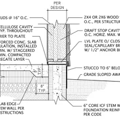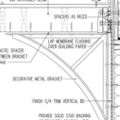Spray foam in cathedral ceiling
I’m building in zone 5 with 2×10 roof rafters. Do you see a problem using 2″ closed cell on the underside of the roof sheathing with the remainder of the cavity filled with open cell in order to achieve the code required R-38?
GBA Detail Library
A collection of one thousand construction details organized by climate and house part










Replies
Scott,
Q. "Do you see a problem?"
A. No.
I should know better than asking a yes/no question of a Vermonter. Can you help me understand why, in the case of a typical flash and batt you say to follow the tables for exterior foam in establishing the thickness of the spray foam (flash) where in the scenario I describe, you think ~R-13 closed cell is sufficient? Is it because open cell foam is air impermeable where fiberglass batt is air permeable? If the answer is a single syllable word other than yes, please clarify. Thanks.
Scott,
Q. "Is it because open-cell foam is air-impermeable where fiberglass batt is air-permeable?"
A. Yes.